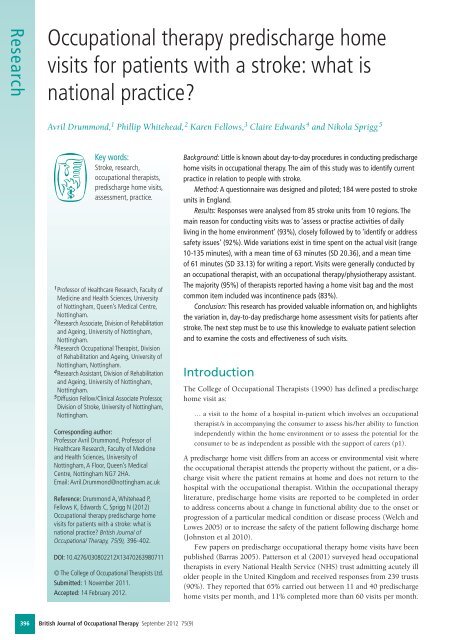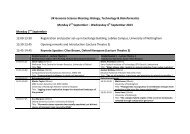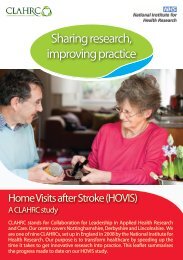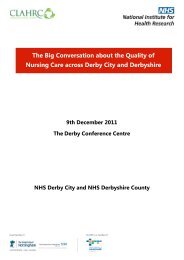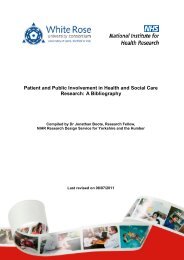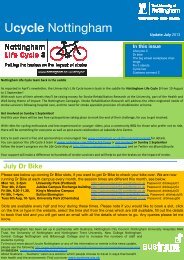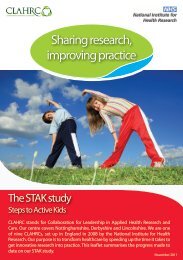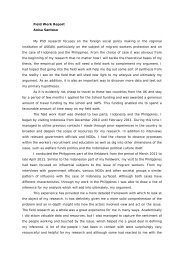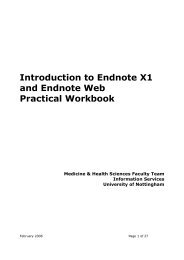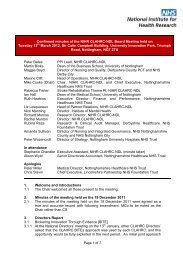Occupational therapy predischarge home visits for patients with a ...
Occupational therapy predischarge home visits for patients with a ...
Occupational therapy predischarge home visits for patients with a ...
Create successful ePaper yourself
Turn your PDF publications into a flip-book with our unique Google optimized e-Paper software.
Research<br />
<strong>Occupational</strong> <strong>therapy</strong> <strong>predischarge</strong> <strong>home</strong><br />
<strong>visits</strong> <strong>for</strong> <strong>patients</strong> <strong>with</strong> a stroke: what is<br />
national practice?<br />
Avril Drummond, 1 Phillip Whitehead, 2 Karen Fellows, 3 Claire Edwards 4 and Nikola Sprigg 5<br />
Key words:<br />
Stroke, research,<br />
occupational therapists,<br />
<strong>predischarge</strong> <strong>home</strong> <strong>visits</strong>,<br />
assessment, practice.<br />
1 Professor of Healthcare Research, Faculty of<br />
Medicine and Health Sciences, University<br />
of Nottingham, Queen’s Medical Centre,<br />
Nottingham.<br />
2 Research Associate, Division of Rehabilitation<br />
and Ageing, University of Nottingham,<br />
Nottingham.<br />
3 Research <strong>Occupational</strong> Therapist, Division<br />
of Rehabilitation and Ageing, University of<br />
Nottingham, Nottingham.<br />
4 Research Assistant, Division of Rehabilitation<br />
and Ageing, University of Nottingham,<br />
Nottingham.<br />
5 Diffusion Fellow/Clinical Associate Professor,<br />
Division of Stroke, University of Nottingham,<br />
Nottingham.<br />
Corresponding author:<br />
Professor Avril Drummond, Professor of<br />
Healthcare Research, Faculty of Medicine<br />
and Health Sciences, University of<br />
Nottingham, A Floor, Queen’s Medical<br />
Centre, Nottingham NG7 2HA.<br />
Email: Avril.Drummond@nottingham.ac.uk<br />
Reference: Drummond A, Whitehead P,<br />
Fellows K, Edwards C, Sprigg N (2012)<br />
<strong>Occupational</strong> <strong>therapy</strong> <strong>predischarge</strong> <strong>home</strong><br />
<strong>visits</strong> <strong>for</strong> <strong>patients</strong> <strong>with</strong> a stroke: what is<br />
national practice? British Journal of<br />
<strong>Occupational</strong> Therapy, 75(9), 396-402.<br />
DOI: 10.4276/030802212X13470263980711<br />
© The College of <strong>Occupational</strong> Therapists Ltd.<br />
Submitted: 1 November 2011.<br />
Accepted: 14 February 2012.<br />
Background: Little is known about day-to-day procedures in conducting <strong>predischarge</strong><br />
<strong>home</strong> <strong>visits</strong> in occupational <strong>therapy</strong>. The aim of this study was to identify current<br />
practice in relation to people <strong>with</strong> stroke.<br />
Method: A questionnaire was designed and piloted; 184 were posted to stroke<br />
units in England.<br />
Results: Responses were analysed from 85 stroke units from 10 regions. The<br />
main reason <strong>for</strong> conducting <strong>visits</strong> was to ‘assess or practise activities of daily<br />
living in the <strong>home</strong> environment’ (93%), closely followed by to ‘identify or address<br />
safety issues’ (92%). Wide variations exist in time spent on the actual visit (range<br />
10-135 minutes), <strong>with</strong> a mean time of 63 minutes (SD 20.36), and a mean time<br />
of 61 minutes (SD 33.13) <strong>for</strong> writing a report. Visits were generally conducted by<br />
an occupational therapist, <strong>with</strong> an occupational <strong>therapy</strong>/physio<strong>therapy</strong> assistant.<br />
The majority (95%) of therapists reported having a <strong>home</strong> visit bag and the most<br />
common item included was incontinence pads (83%).<br />
Conclusion: This research has provided valuable in<strong>for</strong>mation on, and highlights<br />
the variation in, day-to-day <strong>predischarge</strong> <strong>home</strong> assessment <strong>visits</strong> <strong>for</strong> <strong>patients</strong> after<br />
stroke. The next step must be to use this knowledge to evaluate patient selection<br />
and to examine the costs and effectiveness of such <strong>visits</strong>.<br />
Introduction<br />
The College of <strong>Occupational</strong> Therapists (1990) has defined a <strong>predischarge</strong><br />
<strong>home</strong> visit as:<br />
… a visit to the <strong>home</strong> of a hospital in-patient which involves an occupational<br />
therapist/s in accompanying the consumer to assess his/her ability to function<br />
independently <strong>with</strong>in the <strong>home</strong> environment or to assess the potential <strong>for</strong> the<br />
consumer to be as independent as possible <strong>with</strong> the support of carers (p1).<br />
A <strong>predischarge</strong> <strong>home</strong> visit differs from an access or environmental visit where<br />
the occupational therapist attends the property <strong>with</strong>out the patient, or a discharge<br />
visit where the patient remains at <strong>home</strong> and does not return to the<br />
hospital <strong>with</strong> the occupational therapist. Within the occupational <strong>therapy</strong><br />
literature, <strong>predischarge</strong> <strong>home</strong> <strong>visits</strong> are reported to be completed in order<br />
to address concerns about a change in functional ability due to the onset or<br />
progression of a particular medical condition or disease process (Welch and<br />
Lowes 2005) or to increase the safety of the patient following discharge <strong>home</strong><br />
(Johnston et al 2010).<br />
Few papers on <strong>predischarge</strong> occupational <strong>therapy</strong> <strong>home</strong> <strong>visits</strong> have been<br />
published (Barras 2005). Patterson et al (2001) surveyed head occupational<br />
therapists in every National Health Service (NHS) trust admitting acutely ill<br />
older people in the United Kingdom and received responses from 239 trusts<br />
(90%). They reported that 65% carried out between 11 and 40 <strong>predischarge</strong><br />
<strong>home</strong> <strong>visits</strong> per month, and 11% completed more than 60 <strong>visits</strong> per month.<br />
396 British Journal of <strong>Occupational</strong> Therapy September 2012 75(9)
Avril Drummond, Phillip Whitehead, Karen Fellows, Claire Edwards and Nikola Sprigg<br />
Thirty per cent completed <strong>home</strong> <strong>visits</strong> <strong>with</strong> more than half<br />
of all <strong>patients</strong>. An occupational therapist was present on<br />
all these <strong>visits</strong>.<br />
Lannin et al (2011) surveyed 215 public and private<br />
hospitals in New South Wales, Australia. They received 52<br />
responses, a 25% response rate, and reported an average of<br />
13 <strong>predischarge</strong> <strong>home</strong> <strong>visits</strong> per month (range 1 to 60). They<br />
also found that in 40 of the 47 departments that completed<br />
<strong>home</strong> <strong>visits</strong>, more than half of all <strong>patients</strong> had a visit. Home<br />
<strong>visits</strong> took an average of 1 hour and 20 minutes to complete<br />
and 2 hours including travel time.<br />
Figures from these publications suggest that <strong>predischarge</strong><br />
<strong>home</strong> <strong>visits</strong> are a common component of occupational <strong>therapy</strong><br />
<strong>for</strong> older people in acute care settings. With regard to stroke,<br />
data on <strong>home</strong> <strong>visits</strong> were recorded in the 2006 National<br />
Sentinel Stroke Audit, which reported that 73% of <strong>patients</strong><br />
admitted to a stroke unit had a <strong>home</strong> visit be<strong>for</strong>e discharge<br />
(Intercollegiate Stroke Working Party 2007). Although this<br />
figure must be regarded cautiously (units were asked about<br />
visiting ‘appropriate’ <strong>patients</strong> and there may have been confusion<br />
in interpreting what this meant), it would seem that<br />
<strong>home</strong> <strong>visits</strong> are carried out routinely. However, little is known<br />
about current occupational <strong>therapy</strong> <strong>home</strong> visiting practice.<br />
It is unclear whether there are regional variations in the<br />
number of <strong>visits</strong> completed, who routinely attends the <strong>visits</strong>,<br />
how in<strong>for</strong>mation collected on the visit is communicated, how<br />
much time they take, what basic equipment is taken and<br />
what the occupational therapist carries on the <strong>visits</strong>.<br />
Thus the aim of this study was to address this dearth of<br />
knowledge and to collect up-to-date in<strong>for</strong>mation to describe<br />
the practice of <strong>predischarge</strong> <strong>home</strong> <strong>visits</strong> by occupational therapists<br />
working in inpatient stroke care. The research question<br />
was as follows: ‘What is routine occupational <strong>therapy</strong> practice<br />
when conducting <strong>predischarge</strong> <strong>home</strong> <strong>visits</strong> <strong>for</strong> <strong>patients</strong><br />
<strong>with</strong> a stroke?’<br />
Method<br />
Questionnaire<br />
As no suitable instrument already existed, a questionnaire was<br />
designed using previous literature in the field (Patterson et al<br />
2001, Lannin et al 2011) and input from local stroke clinical<br />
occupational therapists and from occupational <strong>therapy</strong><br />
researchers. A copy of the questionnaire used by Lannin<br />
et al (2011) was also obtained and some of the questions in<br />
their survey were adapted (<strong>with</strong> their permission) <strong>for</strong> the<br />
purposes of this study.<br />
The questionnaire was designed to identify current<br />
practice in <strong>predischarge</strong> occupational <strong>therapy</strong> <strong>home</strong> <strong>visits</strong><br />
following stroke and covered the following topic areas:<br />
1. Number of <strong>predischarge</strong> <strong>home</strong> <strong>visits</strong> completed – respondents<br />
were asked to calculate how many <strong>predischarge</strong><br />
<strong>home</strong> <strong>visits</strong> were completed in their stroke unit during<br />
the months of April and May 2011.<br />
2. <strong>Occupational</strong> therapists’ reasons <strong>for</strong> conducting <strong>home</strong><br />
<strong>visits</strong> – the occupational therapists were provided <strong>with</strong><br />
a list of possible reasons <strong>for</strong> completing a <strong>predischarge</strong><br />
<strong>home</strong> visit and asked to select all those that applied.<br />
3. Time spent on <strong>home</strong> <strong>visits</strong> – respondents were asked to<br />
report the average time spent completing <strong>home</strong> <strong>visits</strong>,<br />
including time spent at the <strong>home</strong>, travel time, organising<br />
the visit and writing up the <strong>home</strong> visit report.<br />
4. Procedures – those surrounding <strong>home</strong> <strong>visits</strong> and staff<br />
routinely attending the visit.<br />
5. Home visit reporting – what happens to the completed<br />
report in routine practice (respondents could select<br />
multiple options).<br />
6. Contents of a <strong>home</strong> visiting bag – respondents were<br />
asked if they routinely took anything else on a visit in<br />
addition to the contents of the <strong>home</strong> visit bag.<br />
Specific additional space was also provided <strong>for</strong> other<br />
comments; respondents were asked if there was anything else<br />
they would like to add about <strong>home</strong> visiting either (i) in the<br />
stroke unit where they worked or (ii) more generally relating<br />
to occupational <strong>therapy</strong>.<br />
Although the questionnaire related only to <strong>predischarge</strong><br />
<strong>home</strong> <strong>visits</strong> (as defined above) and not to access or discharge<br />
<strong>visits</strong>, in<strong>for</strong>mation was also collected on the number of<br />
these <strong>visits</strong> conducted.<br />
Piloting<br />
The questionnaire was initially sent to six local clinical occupational<br />
therapists, from two different hospitals, treating<br />
people <strong>with</strong> stroke. The questionnaire was also sent to<br />
four researchers <strong>with</strong> expertise in stroke research. No major<br />
revisions were made as a result of piloting, although several<br />
questions were rephrased to improve clarity, and the overall<br />
layout was revised to make the questionnaire more visually<br />
appealing and easier to complete.<br />
Procedure<br />
A list of 184 hospitals that had stroke units in England was<br />
obtained from the Royal College of Physicians National<br />
Sentinel Stroke Audit 2010 (Intercollegiate Stroke Working<br />
Party 2011). Questionnaires were posted <strong>with</strong> a covering<br />
letter explaining the purpose of the study and an addressed<br />
envelope <strong>for</strong> return of the completed questionnaire. The<br />
packages were addressed to ‘The Lead <strong>Occupational</strong> Therapist,<br />
The Stroke Unit’. The letter encouraged therapists to complete<br />
two questionnaires if there were two distinct parts to their<br />
service, <strong>for</strong> example, acute / hyperacute and rehabilitation;<br />
this could be done by contacting the authors <strong>for</strong> another copy<br />
or by photocopying the questionnaire themselves. In the covering<br />
letter, the occupational therapists were offered a certificate<br />
<strong>for</strong> continuing professional development in recognition that<br />
they had assisted <strong>with</strong> a stroke research project.<br />
Each questionnaire was given an identifiable code in<br />
order to ascertain the geographical spread of the sample of<br />
returned questionnaires.<br />
In addition, the study was advertised by emailing members<br />
of the specialist sections of the College of <strong>Occupational</strong><br />
Therapists <strong>for</strong> older people and neurological practice<br />
(COTSS-OP, COTSS-NP) and by personal contacts. This<br />
British Journal of <strong>Occupational</strong> Therapy September 2012 75(9)<br />
397
<strong>Occupational</strong> <strong>therapy</strong> <strong>predischarge</strong> <strong>home</strong> <strong>visits</strong> <strong>for</strong> <strong>patients</strong> <strong>with</strong> a stroke: what is national practice?<br />
was to alert therapists to the survey arriving in their hospital,<br />
and to encourage them to complete it.<br />
Respondents were initially given 3 weeks to return the<br />
questionnaire. A further reminder was emailed to the<br />
COTSS-OP and COTSS-NP members. However, the final<br />
deadline was extended when several occupational therapists<br />
contacted the research team to say that they were returning<br />
their questionnaires later. No <strong>for</strong>mal reminders were sent.<br />
Fig. 1. Regional distribution of respondents.<br />
Analysis<br />
When all the data had been collected, they were entered onto<br />
SPSS (version 16) <strong>for</strong> analysis using descriptive statistics. Two<br />
researchers were involved in the initial data coding (PW, CE).<br />
One researcher then entered the data (CE), which was double<br />
checked by another (PW). A random sample of 10% of the<br />
questionnaires entered was then checked (PW, KF) be<strong>for</strong>e<br />
the data were analysed.<br />
Ethical approval<br />
Ethical approval <strong>for</strong> the Home Visit after Stroke (HOVIS)<br />
study, including administering this questionnaire, was provided<br />
by Berkshire Research Ethics Committee in May 2010<br />
(reference 10/H0505/41).<br />
Results<br />
Sample<br />
Eighty-seven questionnaires were returned (response rate of<br />
47%) from 81 NHS sites (6 sites returned a separate questionnaire<br />
<strong>for</strong> both the acute and the rehabilitation units).<br />
However, 2 questionnaires were returned too late to be<br />
included, thus a total of 85 questionnaires was analysed.<br />
Responses were obtained from 10 regions in England, <strong>with</strong><br />
the majority (16%) from the West Midlands. The geographical<br />
distribution of the stroke units is displayed in Fig. 1.<br />
Questionnaires were returned from a variety of clinical settings:<br />
29 mixed units (34%), 26 rehabilitation units (31%),<br />
26 acute units (31%) and 3 other types of unit (3%). This<br />
in<strong>for</strong>mation was missing from one questionnaire (1%).<br />
The average number of beds on the stroke units was 24<br />
(n = 79, mean = 24.15, SD 9.23, range 8-76). In terms of the<br />
availability of community follow-up services, 69% of stroke<br />
units had a community intermediate care team, 55% had a<br />
community stroke team, 46% had neurological /stroke out<strong>patients</strong>’<br />
services and 43% had an early supported discharge<br />
team. The results are discussed under the topic headings used<br />
in the questionnaires. Please note that ‘missing’ responses are<br />
not always from the same respondent.<br />
Numbers of <strong>predischarge</strong> <strong>home</strong> <strong>visits</strong><br />
completed<br />
The results are shown in Table 1 <strong>for</strong> all units combined and<br />
also split into acute, rehabilitation and mixed units. The average<br />
length of stay was 25 days (n = 62, mean = 25.18, SD 16.26,<br />
range 4-92). The average number of <strong>visits</strong> completed by all<br />
units in April and May combined was 7 (that is, approximately<br />
one per week). As expected, in the acute units the average<br />
number of <strong>visits</strong> was lower, <strong>with</strong> a mean of 3 in April and May<br />
combined. In the rehabilitation units, the average number<br />
of <strong>visits</strong> was higher: 12 in April and May combined. In the<br />
mixed units, the average was 8. Seventy-four per cent of units<br />
provided their actual figures, and 26% estimated the number.<br />
The respondents were also asked to calculate the proportions<br />
of <strong>patients</strong> who had a <strong>predischarge</strong> <strong>home</strong> visit from<br />
their stroke unit in April and May (combined). Seventeen<br />
(20%) stroke units did not complete any <strong>home</strong> <strong>visits</strong> during<br />
this period. Thirty-seven (44%) did complete <strong>home</strong> <strong>visits</strong>,<br />
but <strong>with</strong> 25% or fewer <strong>patients</strong>. Only 7 (8%) stroke units completed<br />
<strong>home</strong> <strong>visits</strong> <strong>with</strong> more than 50% of <strong>patients</strong> and these<br />
were all rehabilitation units.<br />
<strong>Occupational</strong> therapists’ reasons <strong>for</strong><br />
conducting <strong>home</strong> <strong>visits</strong><br />
The occupational therapists were provided <strong>with</strong> a list of<br />
possible reasons <strong>for</strong> completing a <strong>predischarge</strong> <strong>home</strong> visit<br />
and asked to select all those that applied. Table 2 shows the<br />
overall percentages of respondents who stated that they<br />
completed a <strong>home</strong> visit <strong>for</strong> these reasons. The main reason<br />
cited was ‘to assess or practise activities of daily living<br />
in the <strong>home</strong> environment’, selected by 79 (93%); 78 (92%)<br />
stated that they would do a visit to ‘identify or address safety<br />
issues’, and 75 (88%) stated that they would complete a<br />
visit to ‘assess or practise mobility or transfers in the <strong>home</strong><br />
environment’. <strong>Occupational</strong> therapists were also given the<br />
opportunity to give free text responses as to the reasons<br />
<strong>for</strong> completing a <strong>home</strong> visit, and 39% did so. These reasons<br />
included: to increase patient’s insight; because of concerns<br />
about cognition, vision, orientation or perception; to decrease<br />
family anxiety; and to train carers.<br />
398 British Journal of <strong>Occupational</strong> Therapy September 2012 75(9)
Avril Drummond, Phillip Whitehead, Karen Fellows, Claire Edwards and Nikola Sprigg<br />
Table 1. Numbers of <strong>predischarge</strong> <strong>home</strong> <strong>visits</strong> completed<br />
Units Length of stay in days Number of <strong>home</strong> <strong>visits</strong><br />
n Range Mean (SD) n Range* Mean (SD)<br />
Acute ........................................................17................4-22................12.65 (4.97)...........................25...............0-20...................2.52 (4.09)...............<br />
Rehabilitation ..........................................19..............21-60 ...............36.84 (11.75)...........................25...............1-27.................11.76 (7.68)...............<br />
Mixed......................................................24................8-92 ...............25.17 (18.59)...........................30...............0-20...................7.47 (5.70)...............<br />
Hyperacute ................................................1.................N/A ..................[21] ............................................1................N/A .....................[0]...........................<br />
Other.........................................................1.................N/A ..................[21] ............................................2...............0-8.....................4.00 (5.66)...............<br />
All units (Total) ........................................62................4-92................25.18 (16.26)...........................83...............0-27...................7.10 (6.93)...............<br />
*Visits in 2 month period (April and May 2011). [ ] only one response.<br />
NB. Twenty-three units did not provide in<strong>for</strong>mation <strong>for</strong> length of stay; 2 units did not provide in<strong>for</strong>mation <strong>for</strong> number of <strong>home</strong> <strong>visits</strong>.<br />
Table 2. <strong>Occupational</strong> therapists’ reasons <strong>for</strong> completing <strong>home</strong> <strong>visits</strong><br />
Reason Frequency Percentage<br />
(n = 85)<br />
Assess/practise activities of daily living<br />
in <strong>home</strong> environment .........................................79...................93%........<br />
Identify/address safety issues..............................78...................92%........<br />
Assess/practise mobility/transfers in<br />
<strong>home</strong> environment .............................................75...................88%........<br />
As part of discharge planning .............................66...................77%........<br />
Carer concerns ...................................................63...................74%........<br />
Assess access to and <strong>with</strong>in property ..................63...................74%........<br />
Increase patient’s confidence and mood..............59...................69%........<br />
Equipment provision...........................................49...................58%........<br />
In<strong>for</strong>m ongoing rehabilitation goals ....................42...................49%........<br />
Other .................................................................33...................39%........<br />
Obtain measurements ........................................31...................37%........<br />
Stroke unit policy..................................................4.....................5%........<br />
Missing (respondents who did not complete<br />
this question) .......................................................3.....................4%........<br />
Time spent on <strong>home</strong> <strong>visits</strong><br />
There was a wide range in average times reported. The average<br />
time spent at the <strong>home</strong> was 63 minutes (n = 84, mean = 62.88,<br />
SD 20.36, range 10-135); time writing the <strong>home</strong> visit report<br />
was 61 minutes (n = 84, mean = 61.05, SD 33.13, range 2-210);<br />
average time spent organising the visit was 50 minutes (n = 84,<br />
mean = 49.98, SD 34.58, range 10-240); and travel time to<br />
and from the hospital was 49 minutes (n = 84, mean = 48.70,<br />
SD 25.41, range 15-180). The total time spent completing one<br />
<strong>home</strong> visit (including preparation, travel and report writing)<br />
was an average of 223 minutes (n = 84, mean = 222.61, SD 76.28,<br />
range 100-570). This is approximately half a day of occupational<br />
<strong>therapy</strong> time (3 hours, 43 minutes). However, it should<br />
be noted that the figure of 570 minutes was an outlier; the<br />
next figures were grouped around 6-7 hours.<br />
Procedures surrounding <strong>home</strong> <strong>visits</strong><br />
Seventy-four (87%) of the stroke units reported that it was<br />
hospital policy to have two staff members present on a <strong>home</strong><br />
visit. An occupational therapist was present on all <strong>visits</strong><br />
(either an occupational therapist or a senior occupational<br />
therapist) in all units. Other people who would routinely<br />
attend were: occupational <strong>therapy</strong>/physio<strong>therapy</strong> assistants<br />
(93% of stroke units), family members (93%) and physiotherapists<br />
(60%). The most popular combination of staff<br />
attending a <strong>home</strong> visit was an occupational therapist <strong>with</strong><br />
an occupational <strong>therapy</strong>/physio<strong>therapy</strong> assistant (78%).<br />
The results are shown in Table 3.<br />
One occupational therapist noted that in her unit a risk<br />
assessment was carried out on <strong>patients</strong> and on this basis only an<br />
occupational therapist might attend the visit <strong>with</strong> the patient.<br />
The most common method of transport used <strong>for</strong> <strong>visits</strong> was<br />
a pool car (52% of stroke units); this was followed by a taxi<br />
(26%), ambulance (8%), staff member’s own transport (7%)<br />
and other transport methods (4%), <strong>for</strong> example, hospital<br />
transport <strong>with</strong> wheelchair access, mobility link transport<br />
and voluntary services (3% ‘missing’).<br />
Table 3. Staff present on <strong>home</strong> <strong>visits</strong><br />
Who would be present on Frequency Percentage<br />
<strong>visits</strong> in addition to an<br />
occupational therapist?<br />
<strong>Occupational</strong> <strong>therapy</strong>/physio<strong>therapy</strong> assistant..........79 ................93%.......<br />
Family member .......................................................79 ................93%.......<br />
<strong>Occupational</strong> <strong>therapy</strong> student ..................................61 ................72%.......<br />
Physiotherapist .......................................................51 ................60%.......<br />
Student (other discipline) ........................................43 ................51%.......<br />
Social worker/care manager ....................................31 ................37%.......<br />
Formal carer..............................................................19 ................22%.......<br />
Other.......................................................................15 ................18%.......<br />
Nurse .......................................................................8 ..................9%.......<br />
Speech and language therapist .................................7 ..................8%.......<br />
Home visit reporting<br />
Eighty-four (99%) of the stroke units reported that a report<br />
or <strong>for</strong>m was routinely completed following a <strong>predischarge</strong><br />
<strong>home</strong> visit. In all cases this was completed by the occupational<br />
therapist (or by an occupational <strong>therapy</strong> assistant <strong>with</strong> input<br />
from an occupational therapist). Eighty-three per cent of the<br />
units reported that this was a pro<strong>for</strong>ma report or <strong>for</strong>m and<br />
12% reported that the <strong>for</strong>mat of the report was at the discretion<br />
of each individual therapist (5% missing).<br />
Seventy-five (88%) units filed the report in the patient’s<br />
medical notes, 47 (55%) filed it in the occupational <strong>therapy</strong><br />
notes, 49 (58%) <strong>for</strong>warded the report to other health service<br />
British Journal of <strong>Occupational</strong> Therapy September 2012 75(9)<br />
399
<strong>Occupational</strong> <strong>therapy</strong> <strong>predischarge</strong> <strong>home</strong> <strong>visits</strong> <strong>for</strong> <strong>patients</strong> <strong>with</strong> a stroke: what is national practice?<br />
Fig. 2. What is in the <strong>home</strong> visit bag?<br />
Comments<br />
Seventy (82.5%) occupational therapists reported that, in their<br />
opinion, <strong>home</strong> <strong>visits</strong> were completed <strong>with</strong> the ‘right number’<br />
of <strong>patients</strong> and 13 (15%) reported that <strong>home</strong> <strong>visits</strong> were completed<br />
<strong>with</strong> ‘not enough’ <strong>patients</strong>. There were no respondents<br />
who reported that <strong>home</strong> <strong>visits</strong> were completed <strong>with</strong> ‘too many’<br />
<strong>patients</strong> (two respondents did not answer this question, 2.5%).<br />
Space was provided <strong>for</strong> any additional comments on <strong>home</strong><br />
visiting and 72% (n = 61) took this opportunity. Interestingly,<br />
there were marked variations in the therapists’ opinions of<br />
<strong>visits</strong>. Some felt very strongly <strong>for</strong> visiting:<br />
Home <strong>visits</strong> are an essential part of practice as <strong>patients</strong> can<br />
present very differently in their own environment (039).<br />
I believe it should be made a policy that all <strong>patients</strong> that have<br />
had a stroke have a <strong>predischarge</strong> OT <strong>home</strong> visit (132).<br />
Unique still to OT … should be protected … and not become<br />
generic (042).<br />
Others felt that there were difficulties:<br />
There are often requests <strong>for</strong> <strong>visits</strong> which I feel are inappropriate<br />
(127).<br />
They are popular <strong>with</strong> patient and staff however they lack some<br />
understanding of how much time and ef<strong>for</strong>t they take (088).<br />
teams in the community, 20 (24%) sent a copy to the patient’s<br />
general practitioner, 12 (14%) gave a copy to a relative or<br />
family member, and 10 (12%) gave a copy to the patient.<br />
Contents of a <strong>home</strong> visiting bag<br />
Eighty-one (95%) of the stroke units reported having a <strong>home</strong><br />
visit bag, which was taken on all <strong>home</strong> <strong>visits</strong>. The contents<br />
of the <strong>home</strong> visit bags are shown in Fig. 2. The most common<br />
items included in the <strong>home</strong> visit bag were incontinence pads<br />
(83%), gloves (76%), vomit bowl (73%) and apron (67%).<br />
Respondents routinely took other items in addition to the<br />
contents of the <strong>home</strong> visit bag. Sixty-five per cent took milk,<br />
21% took food, 21% took mobility aids/equipment, 15% took<br />
a mobile phone and 8% took tea bags.<br />
Other <strong>visits</strong><br />
Respondents were also asked about the number of access<br />
<strong>visits</strong> (<strong>with</strong>out the patient) and discharge <strong>visits</strong> (where the<br />
patient remains at <strong>home</strong> after the visit) completed in April<br />
and May 2011. The average number of access <strong>visits</strong> completed<br />
per unit in April and May combined was 7 (n = 83,<br />
mean = 7.20, SD 8.39, range 0-38). Of these figures, 61% provided<br />
their actual figures, 33% provided estimates and 6%<br />
did not indicate whether the figures were actual or estimated.<br />
The average number of discharge <strong>visits</strong> completed per unit in<br />
April and May combined was 1 (n = 82, mean = 1.39, SD 3.28,<br />
range 0-16). Eighty-one per cent of units provided actual<br />
figures, 11% provided estimates and 8% did not indicate<br />
whether the figures were actual or estimated. Although occupational<br />
therapists reported that access <strong>visits</strong> were conducted,<br />
40 (47%) said discharge <strong>visits</strong> would not be completed at all.<br />
I don’t think they [<strong>home</strong> <strong>visits</strong>] need to be carried out as a<br />
routine task (106).<br />
There were many comments that underlined that staffing<br />
was a real issue in deciding on whether or not to conduct a visit:<br />
I believe <strong>home</strong> <strong>visits</strong> are good practice <strong>for</strong> most stroke <strong>patients</strong>,<br />
but due to our staffing and pressures on length of stay we are<br />
only able to complete them rarely (150).<br />
I would like to do them more frequently but we are pressurised<br />
<strong>for</strong> time due to poor staffing (096).<br />
We would like to complete more <strong>home</strong> <strong>visits</strong> but limited by<br />
lack of time and staff (052).<br />
However, there were also comments about how early supported<br />
discharge (ESD) schemes and community services, in particular<br />
centres, had reduced the number of <strong>visits</strong> and how<br />
some units were starting to conduct more access <strong>visits</strong> than<br />
<strong>home</strong> assessment <strong>visits</strong>.<br />
Respondents made suggestions, which included involving<br />
other staff grades in visiting:<br />
[We should] explore the role of a band 4 to complete <strong>home</strong><br />
<strong>visits</strong> (159).<br />
They also suggested involving staff from other disciplines:<br />
It is always assumed to be an OT role … there may be some<br />
instances when it could be more appropriate <strong>for</strong> another<br />
profession to lead the visit (039).<br />
We are developing the relationship <strong>with</strong> SaLTs that they attend<br />
<strong>visits</strong> when communication is a safety concern (055).<br />
… feel there is scope <strong>for</strong> other disciplines to increase their<br />
involvement in this (143).<br />
400 British Journal of <strong>Occupational</strong> Therapy September 2012 75(9)
Avril Drummond, Phillip Whitehead, Karen Fellows, Claire Edwards and Nikola Sprigg<br />
Some areas were identified where interesting initiatives<br />
had taken place in practice; <strong>for</strong> example, training specifically<br />
<strong>for</strong> conducting <strong>home</strong> <strong>visits</strong>:<br />
The unit … has set out HV competencies which must be<br />
achieved be<strong>for</strong>e each OT can conduct a HV <strong>with</strong>out another<br />
OT being present (140).<br />
Another unit issued booklets on <strong>home</strong> <strong>visits</strong>, which explained:<br />
… why a <strong>home</strong> visit needs to be carried out and what happens<br />
on the <strong>home</strong> visit (057).<br />
Discussion<br />
This study attempted to determine routine occupational<br />
<strong>therapy</strong> practice <strong>for</strong> <strong>predischarge</strong> <strong>home</strong> <strong>visits</strong> after stroke.<br />
The survey suggested that there were marked variations<br />
between different units in terms of numbers of <strong>visits</strong> completed<br />
and time taken to complete <strong>visits</strong>, organise and write<br />
up. For example, <strong>with</strong> regard to actual time spent on <strong>visits</strong>,<br />
the average was 1 hour, but ranged from a surprisingly short<br />
10 minutes to over 2 hours. The total time spent on the whole<br />
process (preparation, travel, visit and administration) was just<br />
under 4 hours, but again the range was from 1 1 ⁄2 hours to<br />
9 1 ⁄2 hours. Although this upper figure was an outlier, there<br />
were still occupational therapists reporting totals of up to<br />
6 hours. Interestingly, the contact time (63 minutes) was<br />
similar to that reported in the Lannin et al (2011) paper<br />
which was 80 minutes, although this study was <strong>for</strong> older<br />
people and was not stroke specific. Probably one of the most<br />
striking figures from the present research was the amount<br />
of time spent by therapists in writing their reports rather<br />
than spending time in face-to-face contact <strong>with</strong> <strong>patients</strong>.<br />
With regard to actual number of <strong>visits</strong>, the figures are<br />
more difficult to interpret. A 2-month window was selected<br />
in case a month was chosen where the practice on the unit<br />
was not reflective of normal visiting. However, several<br />
respondents said that they felt a longer time band would<br />
have been better. The mean number over the 2 months<br />
was 7, that is, approximately one visit per week but, again,<br />
the range was large: the number of <strong>visits</strong> ranged up to 27.<br />
The figures, as anticipated, were low <strong>for</strong> acute units<br />
and higher <strong>for</strong> the rehabilitation units. The number of <strong>visits</strong><br />
in this survey was lower than reported in the Lannin et al<br />
(2011) and Patterson et al (2001) papers and were lower than<br />
one would have predicted based on the sentinel audit data<br />
from 2006 (Intercollegiate Stroke Working Party 2007), where<br />
three-quarters of <strong>patients</strong> had a <strong>home</strong> visit. This suggests a<br />
reduction in the number of <strong>visits</strong> being per<strong>for</strong>med across<br />
England, although it is not possible to confirm that <strong>with</strong><br />
the data collected here. It is interesting to note how many<br />
therapists relied on an ‘estimate’ of their <strong>visits</strong>: this may be<br />
because they completed the questionnaire <strong>with</strong>out access<br />
to the data or, perhaps, that their unit did not record this<br />
in<strong>for</strong>mation. This in<strong>for</strong>mation is vital in the current economic<br />
climate, where demonstrating cost effectiveness is<br />
increasingly essential <strong>for</strong> the commissioning of services.<br />
Although, generally, there was strong agreement about the<br />
main reasons <strong>for</strong> conducting <strong>visits</strong>, there were clear differences<br />
in opinions regarding how <strong>visits</strong> should be conducted.<br />
Most respondents acknowledged the central role of <strong>home</strong><br />
visit assessment in occupational <strong>therapy</strong>, but some therapists<br />
felt that other disciplines should be more actively involved.<br />
Opinions ranged from those therapists who believed that all<br />
<strong>patients</strong> should be given a visit which should be carried out by<br />
an occupational therapist, to those who cited clinical reasoning<br />
in each individual case and a consideration of the involvement<br />
of other professionals. This variation in perception regarding<br />
the role of <strong>home</strong> <strong>visits</strong> among professionals is the focus of<br />
ongoing research; some progress has been made in this area<br />
<strong>with</strong> regard to the perceptions of <strong>patients</strong> (Atwal et al 2012).<br />
Differences also existed in methods of transport and equipment<br />
taken. It was interesting to note that the most common<br />
items covered in the <strong>home</strong> visit bag related to health and safety<br />
considerations, rather than specifically to occupational <strong>therapy</strong>.<br />
Although this study represents the largest English survey<br />
of <strong>home</strong> <strong>visits</strong> after stroke, it is subject to a number of limitations.<br />
The response rate to the questionnaire was initially<br />
disappointing, but many occupational therapists made contact<br />
subsequently to say that they were too busy <strong>with</strong> paper<br />
work in their service to complete it. This may in itself be an<br />
important study observation. However, an overall response<br />
rate of 47% is acceptable (Oppenheim 2000) and the sample<br />
was from a wide geographical spread. It is un<strong>for</strong>tunate that<br />
the study had to be limited to England: occupational therapists<br />
from Scotland, Wales and Northern Ireland also made contact<br />
to say that they wished to participate in the research. It is clear<br />
from many of the additional comments that there are strong<br />
feelings about <strong>home</strong> visit practice, which may have influenced<br />
the findings: those who did not feel so strongly may<br />
have been those who were less inclined to respond.<br />
Conclusion<br />
This is the first study to collect data on the practice of <strong>home</strong><br />
<strong>visits</strong> after stroke in England. The results highlight the diversity<br />
of practice and also the diversity of opinions regarding<br />
reasons <strong>for</strong> conducting <strong>visits</strong>.<br />
Acknowledgements<br />
■ We are grateful to the members of our steering committee (Professor<br />
Nadina Lincoln, Mr Oswald Newell, Dr Cecily Palmer, Dr Karen Stainer,<br />
Dr Kate Rad<strong>for</strong>d and Dr Nicola Brain).<br />
■ We are grateful to Associate Professor Natasha Lannin, Professor Lindy<br />
Clemson and Dr Annie McCluskey <strong>for</strong> giving us permission to adapt and<br />
use their original <strong>home</strong> visit survey instrument.<br />
■ We are grateful to all the occupational therapists who took the time to<br />
complete this questionnaire and <strong>for</strong> their support <strong>with</strong> the research.<br />
■ This paper presents independent research commissioned by the National<br />
Institute <strong>for</strong> Health Research (NIHR) as part of the Collaboration <strong>for</strong> Leadership<br />
in Applied Health Research and Care – Nottinghamshire, Derbyshire and<br />
Lincolnshire (CLAHRC-NDL). The views expressed are those of the authors<br />
and not necessarily those of the NHS, the NIHR or the Department of Health.<br />
British Journal of <strong>Occupational</strong> Therapy September 2012 75(9)<br />
401
<strong>Occupational</strong> <strong>therapy</strong> <strong>predischarge</strong> <strong>home</strong> <strong>visits</strong> <strong>for</strong> <strong>patients</strong> <strong>with</strong> a stroke: what is national practice?<br />
Key findings<br />
■ There was large variation in visiting practice nationally.<br />
■ Average time <strong>for</strong> visit (including travel and report) was almost 4 hours.<br />
■ A significant proportion of this time was spent writing the report.<br />
What the study has added<br />
This research has provided valuable in<strong>for</strong>mation on day-to-day <strong>home</strong><br />
assessment <strong>visits</strong>. The next step is to use this to evaluate patient selection<br />
and examine the costs and effectiveness of <strong>visits</strong>.<br />
Conflict of interest: None declared.<br />
References<br />
Atwal A, Spiliotopoulou G, Plastow N, McIntyre A, McKay EA (2012) Older<br />
adults’ experiences of occupational <strong>therapy</strong> <strong>predischarge</strong> <strong>home</strong> <strong>visits</strong>:<br />
a systematic thematic synthesis of qualitative research. British Journal<br />
of <strong>Occupational</strong> Therapy, 75(3), 118-27.<br />
Barras S (2005) A systematic and critical review of the literature: the effectiveness<br />
of occupational <strong>therapy</strong> <strong>home</strong> assessment on a range of outcome<br />
measures. Australian <strong>Occupational</strong> Therapy Journal, 52(4), 326-36.<br />
College of <strong>Occupational</strong> Therapists (1990) Statement on <strong>home</strong> visiting <strong>with</strong><br />
hospital in-<strong>patients</strong>. Standards, Policies and Proceedings 170. London:<br />
COT.<br />
Intercollegiate Stroke Working Party (2007) National Sentinel Stroke Audit.<br />
Clinical audit 2006. London: Royal College of Physicians.<br />
Intercollegiate Stroke Working Party (2011) National Sentinel Stroke Audit.<br />
Clinical audit 2010. London: Royal College of Physicians.<br />
Johnston K, Barras S, Grimer-Somers K (2010) Relationship between pre-discharge<br />
occupational <strong>therapy</strong> <strong>home</strong> assessment and prevalence of post-discharge<br />
falls. Journal of Evaluation in Clinical Practice, 16(6), 1333-39.<br />
Lannin N, Clemson L, McCluskey A (2011) Survey of current pre-discharge <strong>home</strong><br />
visiting practices of occupational therapists. Australian <strong>Occupational</strong> Therapy<br />
Journal, 58(3), 172-77.<br />
Oppenheim AN (2000) Questionnaire design, interviewing and attitude<br />
measurement. London: Continuum International Publishing Group.<br />
Patterson C, Viner J, Saville C, Mulley G (2001) Too many pre-discharge <strong>home</strong><br />
assessment <strong>visits</strong> <strong>for</strong> older <strong>patients</strong>? A postal questionnaire survey. Clinical<br />
Rehabilitation, 15(3), 291-95.<br />
Welch A, Lowes S (2005) Home assessment <strong>visits</strong> <strong>with</strong>in the acute setting:<br />
a discussion and literature review. British Journal of <strong>Occupational</strong> Therapy,<br />
68(4), 158-64.<br />
402 British Journal of <strong>Occupational</strong> Therapy September 2012 75(9)


